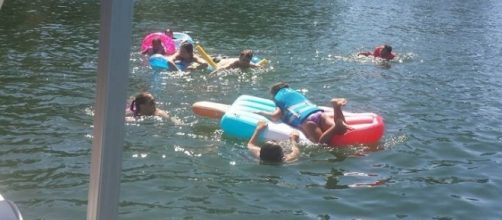A health advisory was issued to Lake Wildwood residents on Saturday, July 29, 2017, due to seven people who reported symptoms of E. coli after swimming at a popular main beach.
Notification
While in Hawaii with my family, all adults who live in Lake Wildwood received an email from the homeowners association not to use the lake at this time due to high fecal counts. The beach that was closed was our favorite swimming spot, so it was with horror we learned that several of the infected were children, one of whom is in critical condition with kidney failure.
The spot is popular because of the lack of goose feces, access to the swimming pool, marina, and snack bar.
Many reports are unsure of how many people have actually contracted the illness because it can take 3-10 days for symptoms to occur and no one knows how long the pathogens have been active. It has been reported that at least six children and one pregnant woman have contracted the illness so far.
The common factor among the sick was a visit to Lake Wildwood’s pool area beach. Those of us who live here know about Hideaway Beach and its constant influx of Canadian geese and the goose feces that line its shores. We rarely visit the beach because the filth is so bad, visitors carry rakes to remove the debris, so children can safely play on the sand and in the water.
While a 7 plus million dollar clubhouse was built on the golf course, which is currently losing money as the number of golfers declines, the lack of care to Lake Wildwood's waters is notable. Lake front homes are still allowed to use water soluble fertilizer on lawns that drain into the lake feeding algae and pond weed. Cow dung, used in fertilizer, contains E.
coli and may contribute to the pathogens growing in the lake. Dredging, which was at one time a yearly occurrence to remove the silt, and allow homeowners to upgrade shorelines and docks, now rarely occurs. Geese, which are a beauty to behold and comforting to hear, are extremely overpopulated on the lake, fouling the beaches, grass, and docks with their droppings.
SolarBees, purchased to aerate the water at the Hideaway Beach area, are currently rotting in the open at a storage facility across the street from Lake Wildwood. The 75 thousand dollar SolarBees were purchased by residents to keep the waters moving in the coves. While reviews of the SolarBees are mixed, something is better than nothing in keeping our waters clean, and at the very least, an expenditure of that amount of money should be better cared for, at least in my opinion.
The dilemma
The Nevada County Environmental Health Department is currently testing water samples from different locations around the lake, and although results were supposed to be in on Monday, residents patiently wait.
My sister-in-law, who is recovering from chemotherapy, and who do not have email or take the newspaper, was warned to get out of the water on Sunday by LWW security who were checking the beaches for swimmers. So far, the Lake Wildwood Homeowners Association has not used the emergency phone network to notify homeowners of the pathogens discovered at the lake creating an issue with homeowners who do not have access to the Internet or take a newspaper.
While uncommon, this type of E. coli can be found naturally in cattle, goats, and even sheep. They may account for 90% of all E. coli 0157.H7 excreted. There are reports that E. coli is naturally present in sand and remains there safely as long as high winds and crashing waves don't drive sand containing E.
coli to the surface. Interestingly, the beach in question is one of two areas that are open to the main lake and waves from boats. Couple that with crushing rains from last winter and you may have the perfect storm.
In addition, there is an ongoing upgrade to the sewer system that treats Lake Wildwood wastewater. New piping is being laid so that Penn Valley proper can now feed into the Lake Wildwood wastewater treatment plant. As of this time, the Nevada Irrigation District denies any problems at the waste treatment plant, despite a time lag in laying the last of the piping which is located directly across from the lake.
While questions remain as to what caused the outbreak, certainly there is more that could have been done to notify homeowners. Not even the signs residents read when entering the community contain a warning, and that is something that should be seen to immediately.


